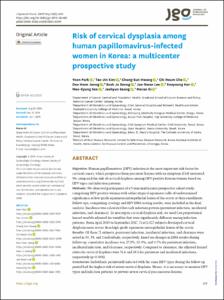KUMEL Repository
1. Journal Papers (연구논문)
1. School of Medicine (의과대학)
Dept. of Obstetrics & Gynecology (산부인과학)
Risk of cervical dysplasia among human papillomavirus-infected women in Korea: a multicenter prospective study
- Affiliated Author(s)
- 조치흠
- Alternative Author(s)
- Cho, Chi Heum
- Journal Title
- Journal of Gynecologic Oncology
- ISSN
- 2005-0399
- Issued Date
- 2019
- Keyword
- Papillomavirus Infections; Uterine Cervical Cancer; Uterine Cervical Dysplasia; Cohort Studies; Republic of Korea
- Abstract
- Objective:
Human papillomavirus (HPV) infection is the most important risk factor for cervical cancer, which progresses from precursor lesions with no symptom if left untreated. We compared the risk of cervical dysplasia among HPV-positive Korean women based on HPV types and infection patterns.
Methods:
We observed participants of a 5-year multicenter prospective cohort study, comprising HPV-positive women with either atypical squamous cells of undetermined significance or low-grade squamous intraepithelial lesion of the cervix at their enrollment. Follow-ups, comprising cytology and HPV DNA testing results, were included in the final analysis. Incidence was calculated for each infection pattern (persistent infection, incidental infection, and clearance). To investigate cervical dysplasia risk, we used Cox proportional hazard models adjusted for variables that were significantly different among infection patterns. From April 2010 to September 2017, 71 of 1,027 subjects developed cervical dysplasia more severe than high-grade squamous intraepithelial lesion of the cervix.
Results:
Of these 71 subjects, persistent infection, incidental infection, and clearance were noted in 30, 39, and 2 individuals, respectively. Based on changes in DNA results during follow-up, cumulative incidence was 27.2%, 10.4%, and 0.5% for persistent infection, incidental infection, and clearance, respectively. Compared to clearance, the adjusted hazard ratios for cervical dysplasia were 51.6 and 24.1 for persistent and incidental infections, respectively (p<0.001).
Conclusion:
Individuals persistently infected with the same HPV types during the follow-up period had the highest risk of severe cervical dysplasia. Hence, it is necessary to monitor HPV types and infection patterns to prevent severe cervical precancerous lesions.
- Department
- Dept. of Obstetrics & Gynecology (산부인과학)
- Publisher
- School of Medicine (의과대학)
- Citation
- Yoon Park et al. (2019). Risk of cervical dysplasia among human papillomavirus-infected women in Korea: a multicenter prospective study. Journal of Gynecologic Oncology, 30(3), e50–e50. doi: 10.3802/jgo.2019.30.e50
- Type
- Article
- ISSN
- 2005-0399
- Appears in Collections:
- 1. School of Medicine (의과대학) > Dept. of Obstetrics & Gynecology (산부인과학)
- 파일 목록
-
-
Download
 oak-2019-0091.pdf
기타 데이터 / 843.76 kB / Adobe PDF
oak-2019-0091.pdf
기타 데이터 / 843.76 kB / Adobe PDF
-
Items in Repository are protected by copyright, with all rights reserved, unless otherwise indicated.